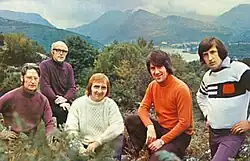Hogia'r Wyddfa
Hogia’r Wyddfa were a Welsh five-piece vocal group with a career in Welsh-language entertainment that lasted fifty years. One of the best-selling Welsh-language groups of the 1970s, they were awarded a gold disc for their 1975 album Caneuon Gorau.
Hogia'r Wyddfa | |
|---|---|
 Hogia'r Wyddfa in Snowdonia (Eryri) in 1974 | |
| Background information | |
| Origin | Llanberis, Wales |
| Genres | Welsh folk music, light music |
| Years active | 1963–2013 |
| Labels | Dryw, Sain |
| Past members | Arwel Jones Elwyn Jones Myrddin Owen Vivian Williams Richard Morris Annette Bryn Parri |
Career
The group formed in 1963 as a trio comprising Arwel Jones, Elwyn Jones and Myrddin Owen.[1] They initially performed under the name Triawd yr Wyddfa (the Snowdon Trio) and gave their first concert to a group of young mothers in their native Llanberis.[2] They became a quintet with the addition of guitarist Vivian Williams and piano accompanist Richard Morris.[1][3][4]
The group were influenced by Triawd y Coleg, admiring the vocal trio's preference for original material rather than imitating English-language music.[5] They adapted poems for some of their material, with Arwel Jones commenting in 2011 "we didn't want to sing covers of English or American songs – the poems of R. Williams Parry and Cynan said much more about us as boys from Llanberis."[6] The group initially received criticism for their practice of adapting poetry, but their songs were later credited with popularising the works they were based on.[6][7] In later years, contemporary Welsh poets wrote lyrics for the group.[7] Their performances took a light entertainment format, with comedy routines interspersed by songs.[6] Actor John Ogwen has credited the group's following to their use of "the wit and culture of the slate quarry workers. The humour has a certain edge but it’s also warm-hearted."[6]
Hogia'r Wyddfa's recording career began in 1968 with the first in a series of EP recordings for Dryw.[8] By the end of the decade, the group's recordings and appearances on television and at Eisteddfodau had made them household names in Wales.[9] In 1971, Hogia'r Wyddfa toured the United States and Canada as part of 48-strong entourage. They performed with Parti'r Ffynnon in Ohio, New York, Michigan and Ontario.[10] By 1972, they were described as "the leading Welsh folk group" by the North Wales Weekly News.[11] In 2017, Myrddin Owen commented "I don’t think there’s a village in Wales where we didn’t perform at least once, the amount of time we spent travelling and performing is almost frightening."[12] In 1973, the group performed at the Royal Albert Hall, an appearance they considered the pinnacle of their career.[3]
They recorded their self-titled first album with Sain in 1974.[13] Alongside tenor Trebor Edwards, they became one of Sain's best-selling acts.[14] In November 1990, Dafydd Iwan presented the group with gold discs for selling more than 10,000 copies of their second Sain album Caneuon Gorau (1975).[15] With Edwards, soprano Marian Roberts and Cerdd Dant exponent Rosalind Owen, the group again toured the United States and Canada in 1984.[1] After the death of Richard Morris,[16] Hogia'r Wyddfa searched for a successor and selected Annette Bryn Parri, who began touring with them in 1992.[7][17] The band continued to perform concerts in the 1990s and released Rhaid i Ni Ddathlu, their first album in over a decade, in 2001.[7]
The group celebrated their 50th anniversary in 2013 with a concert at the National Eisteddfod of Wales in Bala.[18] The concert, televised on S4C, followed the announcement that they would retire.[2]
Elwyn Jones died in 2017 aged 79.[12]
References
- "Bound for the States on a mission of song". Daily Post: 17. 6 July 1984. Retrieved 4 January 2023.
- "Celebrating fifty years of harmony; Join Hogia'r Wyddfa and friends in special concert". The Free Library. Retrieved 5 January 2023.
- Wyn-Williams, Gareth (2 January 2014). "Hogia'r Wyddfa celebrate 50 years on stage". northwales. Retrieved 29 June 2014.
- S4C - Noson Lawen 2013. Hogia’r Wyddfa - Dathlu'r 50. Accessed 27 September 2015
- "Teyrngedau i Cledwyn Jones - un o Driawd y Coleg". BBC. Retrieved 4 January 2023.
- "Hogia'r Wyddfa recall stress and pressure of fame in S4C show". Wales Online. Retrieved 5 January 2023.
- "Happy Hogia'r Wyddfa returns; MUSIC: Welsh-language stalwarts launch first recording in 10 years". The Free Library. Retrieved 5 January 2023.
- Stephens, Meic (2012). Welsh Lives - Gone but Not Forgotten. Y Lolfa. ISBN 9781847716057. Retrieved 5 January 2023.
- "Welsh "pop" scene marks new chapter in eisteddfod tradition". North Wales Weekly News: 17. 26 June 1969. Retrieved 4 January 2023.
- "Two Welsh groups will visit perform Monday at Mt. Gilead". The Delaware Gazette: 4. 28 August 1971. Retrieved 4 January 2023.
- "Musical Sundays at Betws-y-Coed". The North Wales Weekly News: 12. 20 January 1972. Retrieved 4 January 2023.
- Gareth, Wyn-Williams. "Tributes to 'rock' of Welsh music scene Elwyn Jones". North Wales Live. Retrieved 4 January 2023.
- "Beth am nadolig Cymraeg Eleni ?". Carmarthen Journal: 8. 10 December 1976. Retrieved 5 January 2023.
- King, Richard (22 February 2022). Brittle with Relics: A History of Wales, 1962–97. Faber & Faber. ISBN 9780571295661. Retrieved 5 January 2023.
- "One of Wales' most popular singing groups". Caernarfon and Denbigh Herald: 17. 9 November 1990. Retrieved 4 January 2023.
- S4C Cofio - Hogia'r Wyddfa. Accessed 27 September 2015
- Sain Records - Annette Bryn Parri. Accessed 27 September 2015
- "National Eisteddfod: Tickets on sale as 100 day countdown to festival begins". Retrieved 5 January 2023.